Analysis and Design of the My Health Record System for Headspace
VerifiedAdded on 2020/03/16
|10
|2162
|76
Report
AI Summary
This report provides a detailed analysis and design for Headspace's automated health record system. It begins by outlining non-functional requirements such as usability, reliability, performance, and supportability, crucial for the system's success. The report then explores the set of system interfaces, including user interfaces and external systems/devices interfaces, emphasizing responsive design, consistent styling, and secure data transmission. System constraints are also defined, specifying programming languages (PHP) and database solutions. The report reviews cloud-based solutions, recommending the PaaS model within a hybrid cloud deployment for enhanced security and management. It compares predictive and adaptive SDLC approaches, advocating for the Agile methodology due to its flexibility. The report concludes with recommendations for project management (PMBOK) and testing, highlighting the importance of stakeholder communication and thorough defect identification before release. References to various sources are also provided to support the analysis.
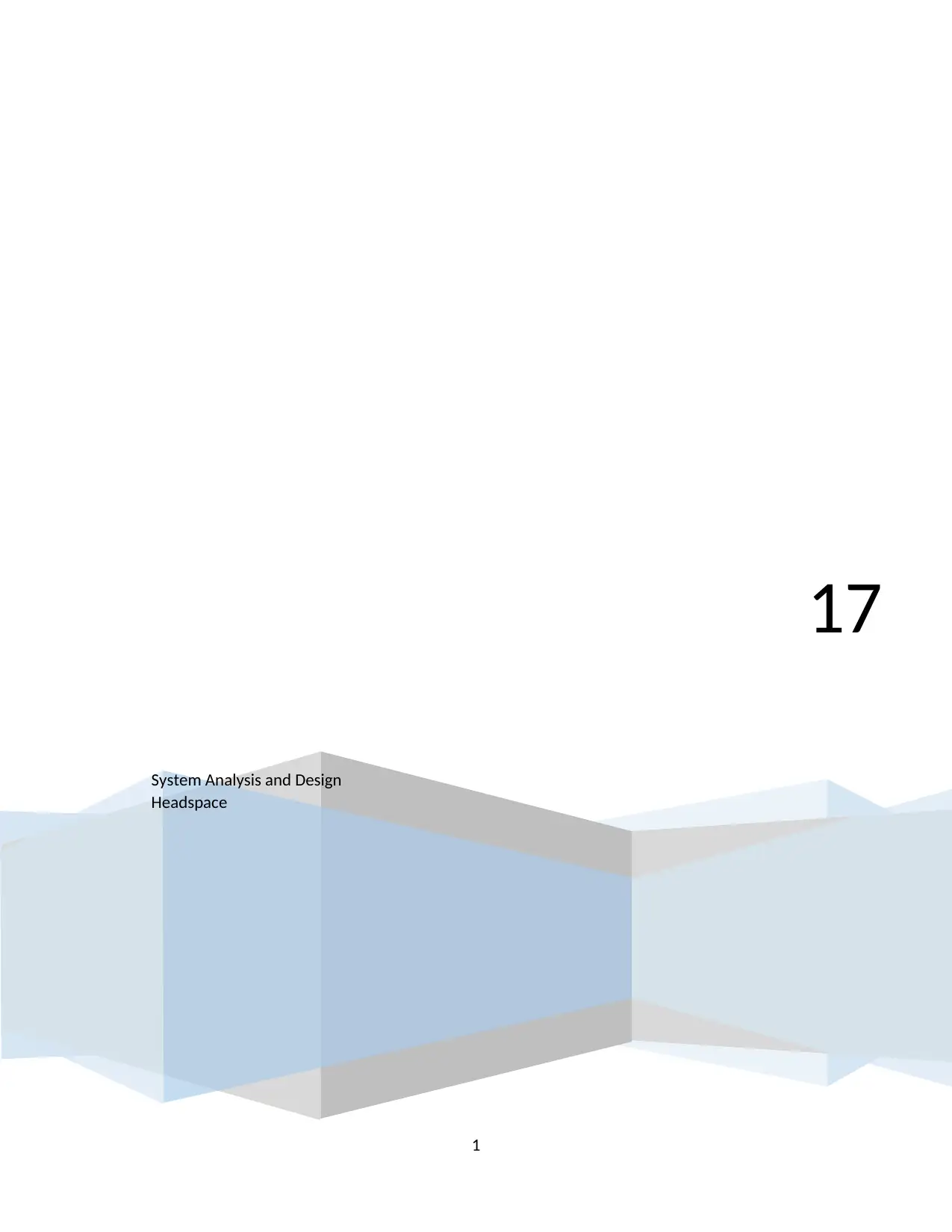
1
System Analysis and Design
Headspace
17
System Analysis and Design
Headspace
17
Paraphrase This Document
Need a fresh take? Get an instant paraphrase of this document with our AI Paraphraser
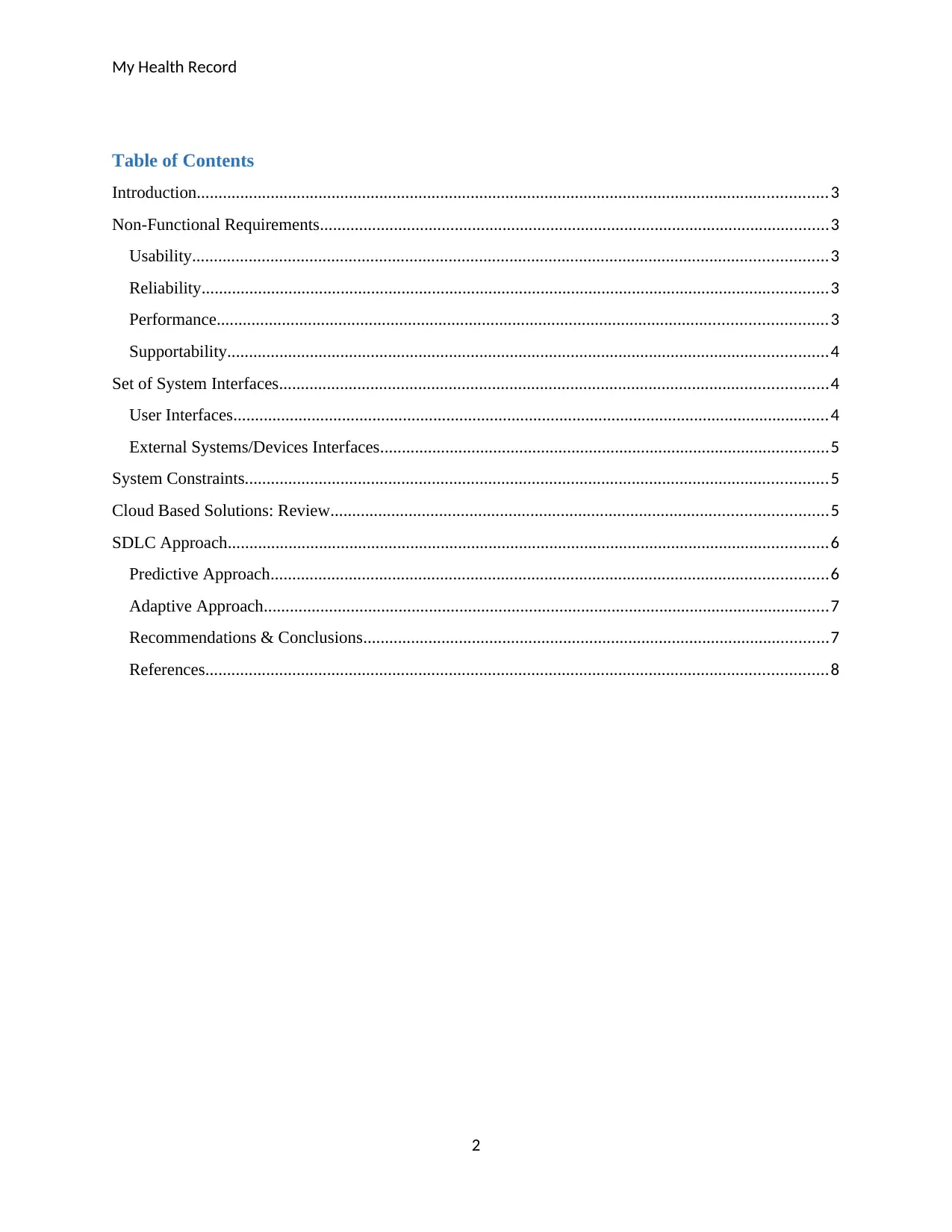
My Health Record
Table of Contents
Introduction.................................................................................................................................................3
Non-Functional Requirements.....................................................................................................................3
Usability..................................................................................................................................................3
Reliability................................................................................................................................................3
Performance............................................................................................................................................3
Supportability..........................................................................................................................................4
Set of System Interfaces..............................................................................................................................4
User Interfaces.........................................................................................................................................4
External Systems/Devices Interfaces.......................................................................................................5
System Constraints......................................................................................................................................5
Cloud Based Solutions: Review..................................................................................................................5
SDLC Approach..........................................................................................................................................6
Predictive Approach................................................................................................................................6
Adaptive Approach..................................................................................................................................7
Recommendations & Conclusions...........................................................................................................7
References...............................................................................................................................................8
2
Table of Contents
Introduction.................................................................................................................................................3
Non-Functional Requirements.....................................................................................................................3
Usability..................................................................................................................................................3
Reliability................................................................................................................................................3
Performance............................................................................................................................................3
Supportability..........................................................................................................................................4
Set of System Interfaces..............................................................................................................................4
User Interfaces.........................................................................................................................................4
External Systems/Devices Interfaces.......................................................................................................5
System Constraints......................................................................................................................................5
Cloud Based Solutions: Review..................................................................................................................5
SDLC Approach..........................................................................................................................................6
Predictive Approach................................................................................................................................6
Adaptive Approach..................................................................................................................................7
Recommendations & Conclusions...........................................................................................................7
References...............................................................................................................................................8
2
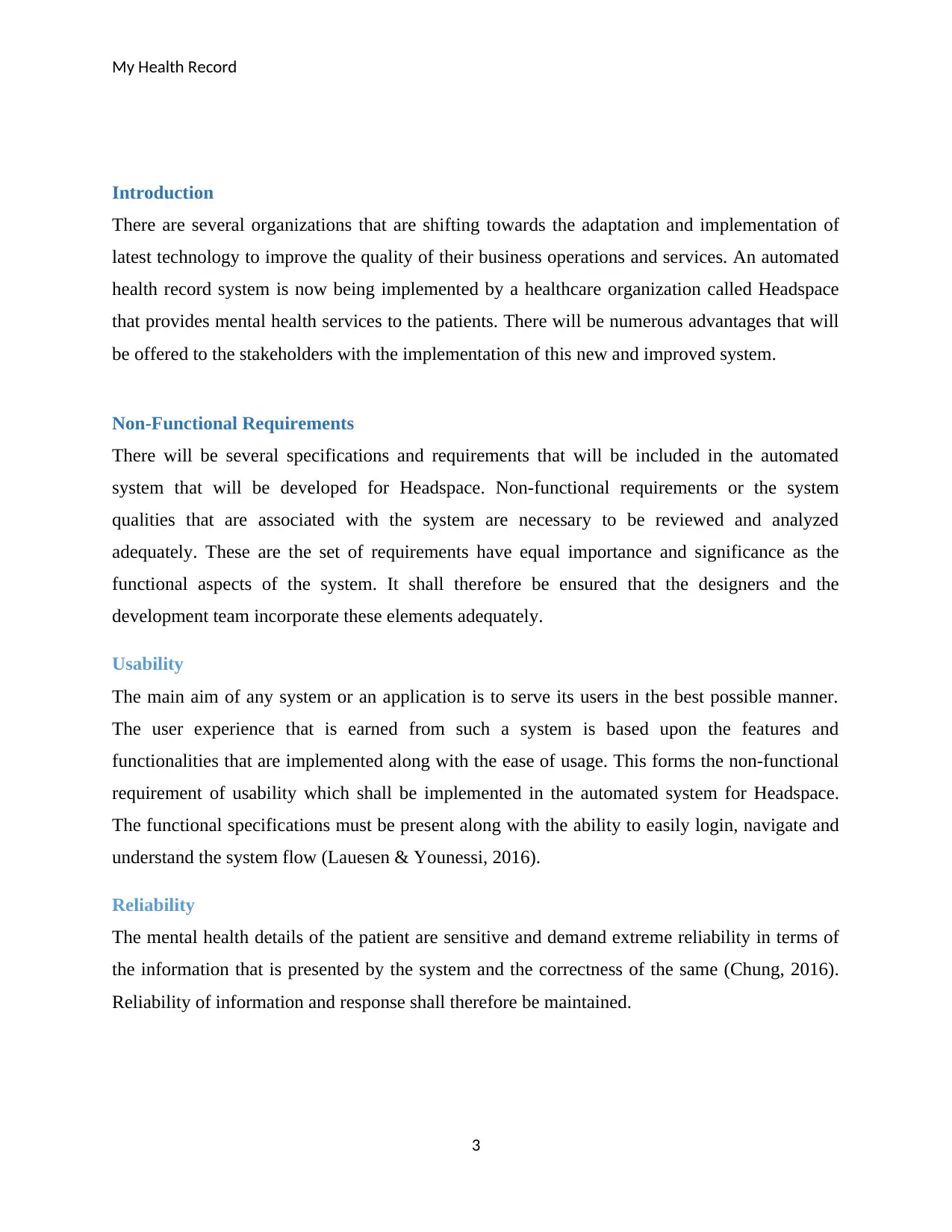
My Health Record
Introduction
There are several organizations that are shifting towards the adaptation and implementation of
latest technology to improve the quality of their business operations and services. An automated
health record system is now being implemented by a healthcare organization called Headspace
that provides mental health services to the patients. There will be numerous advantages that will
be offered to the stakeholders with the implementation of this new and improved system.
Non-Functional Requirements
There will be several specifications and requirements that will be included in the automated
system that will be developed for Headspace. Non-functional requirements or the system
qualities that are associated with the system are necessary to be reviewed and analyzed
adequately. These are the set of requirements have equal importance and significance as the
functional aspects of the system. It shall therefore be ensured that the designers and the
development team incorporate these elements adequately.
Usability
The main aim of any system or an application is to serve its users in the best possible manner.
The user experience that is earned from such a system is based upon the features and
functionalities that are implemented along with the ease of usage. This forms the non-functional
requirement of usability which shall be implemented in the automated system for Headspace.
The functional specifications must be present along with the ability to easily login, navigate and
understand the system flow (Lauesen & Younessi, 2016).
Reliability
The mental health details of the patient are sensitive and demand extreme reliability in terms of
the information that is presented by the system and the correctness of the same (Chung, 2016).
Reliability of information and response shall therefore be maintained.
3
Introduction
There are several organizations that are shifting towards the adaptation and implementation of
latest technology to improve the quality of their business operations and services. An automated
health record system is now being implemented by a healthcare organization called Headspace
that provides mental health services to the patients. There will be numerous advantages that will
be offered to the stakeholders with the implementation of this new and improved system.
Non-Functional Requirements
There will be several specifications and requirements that will be included in the automated
system that will be developed for Headspace. Non-functional requirements or the system
qualities that are associated with the system are necessary to be reviewed and analyzed
adequately. These are the set of requirements have equal importance and significance as the
functional aspects of the system. It shall therefore be ensured that the designers and the
development team incorporate these elements adequately.
Usability
The main aim of any system or an application is to serve its users in the best possible manner.
The user experience that is earned from such a system is based upon the features and
functionalities that are implemented along with the ease of usage. This forms the non-functional
requirement of usability which shall be implemented in the automated system for Headspace.
The functional specifications must be present along with the ability to easily login, navigate and
understand the system flow (Lauesen & Younessi, 2016).
Reliability
The mental health details of the patient are sensitive and demand extreme reliability in terms of
the information that is presented by the system and the correctness of the same (Chung, 2016).
Reliability of information and response shall therefore be maintained.
3
⊘ This is a preview!⊘
Do you want full access?
Subscribe today to unlock all pages.

Trusted by 1+ million students worldwide
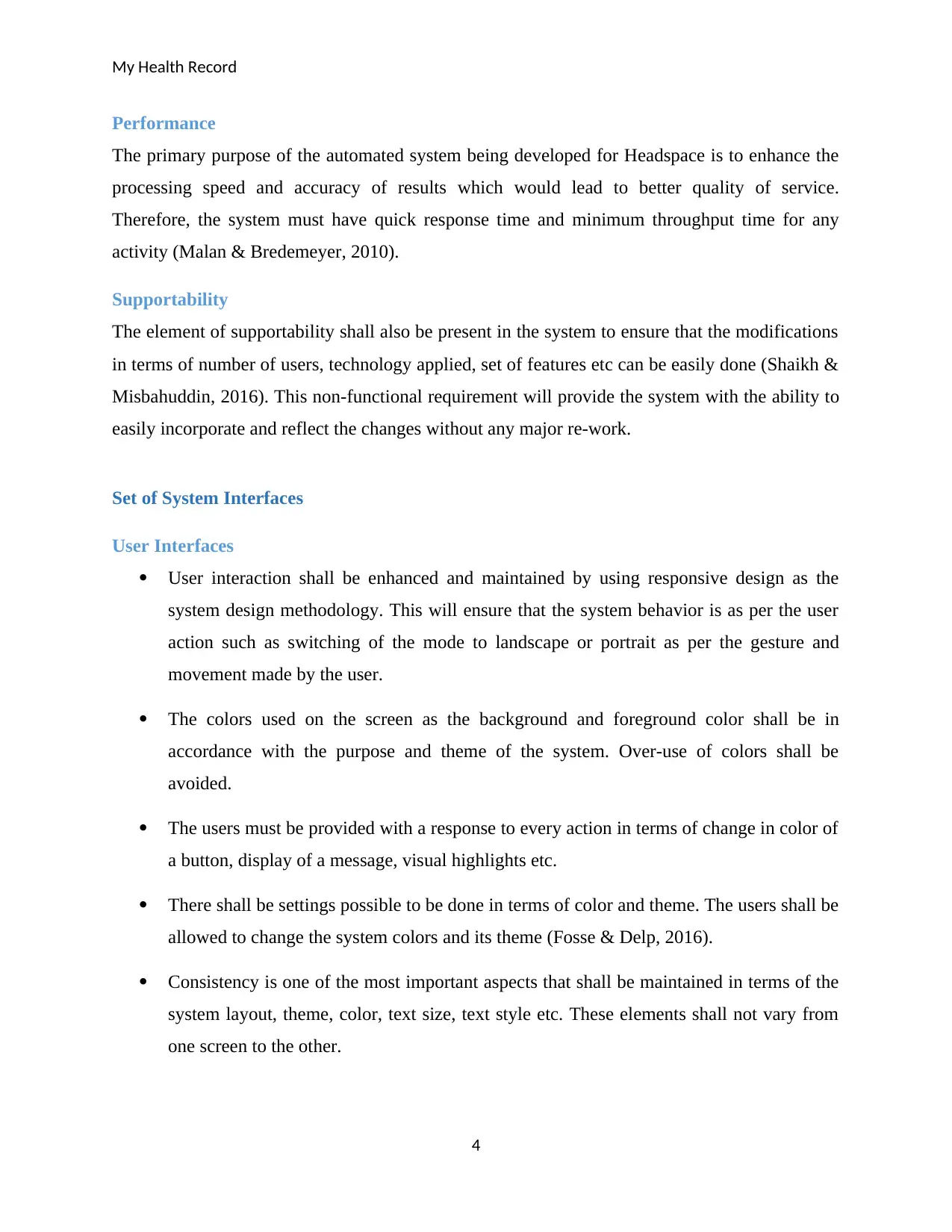
My Health Record
Performance
The primary purpose of the automated system being developed for Headspace is to enhance the
processing speed and accuracy of results which would lead to better quality of service.
Therefore, the system must have quick response time and minimum throughput time for any
activity (Malan & Bredemeyer, 2010).
Supportability
The element of supportability shall also be present in the system to ensure that the modifications
in terms of number of users, technology applied, set of features etc can be easily done (Shaikh &
Misbahuddin, 2016). This non-functional requirement will provide the system with the ability to
easily incorporate and reflect the changes without any major re-work.
Set of System Interfaces
User Interfaces
User interaction shall be enhanced and maintained by using responsive design as the
system design methodology. This will ensure that the system behavior is as per the user
action such as switching of the mode to landscape or portrait as per the gesture and
movement made by the user.
The colors used on the screen as the background and foreground color shall be in
accordance with the purpose and theme of the system. Over-use of colors shall be
avoided.
The users must be provided with a response to every action in terms of change in color of
a button, display of a message, visual highlights etc.
There shall be settings possible to be done in terms of color and theme. The users shall be
allowed to change the system colors and its theme (Fosse & Delp, 2016).
Consistency is one of the most important aspects that shall be maintained in terms of the
system layout, theme, color, text size, text style etc. These elements shall not vary from
one screen to the other.
4
Performance
The primary purpose of the automated system being developed for Headspace is to enhance the
processing speed and accuracy of results which would lead to better quality of service.
Therefore, the system must have quick response time and minimum throughput time for any
activity (Malan & Bredemeyer, 2010).
Supportability
The element of supportability shall also be present in the system to ensure that the modifications
in terms of number of users, technology applied, set of features etc can be easily done (Shaikh &
Misbahuddin, 2016). This non-functional requirement will provide the system with the ability to
easily incorporate and reflect the changes without any major re-work.
Set of System Interfaces
User Interfaces
User interaction shall be enhanced and maintained by using responsive design as the
system design methodology. This will ensure that the system behavior is as per the user
action such as switching of the mode to landscape or portrait as per the gesture and
movement made by the user.
The colors used on the screen as the background and foreground color shall be in
accordance with the purpose and theme of the system. Over-use of colors shall be
avoided.
The users must be provided with a response to every action in terms of change in color of
a button, display of a message, visual highlights etc.
There shall be settings possible to be done in terms of color and theme. The users shall be
allowed to change the system colors and its theme (Fosse & Delp, 2016).
Consistency is one of the most important aspects that shall be maintained in terms of the
system layout, theme, color, text size, text style etc. These elements shall not vary from
one screen to the other.
4
Paraphrase This Document
Need a fresh take? Get an instant paraphrase of this document with our AI Paraphraser
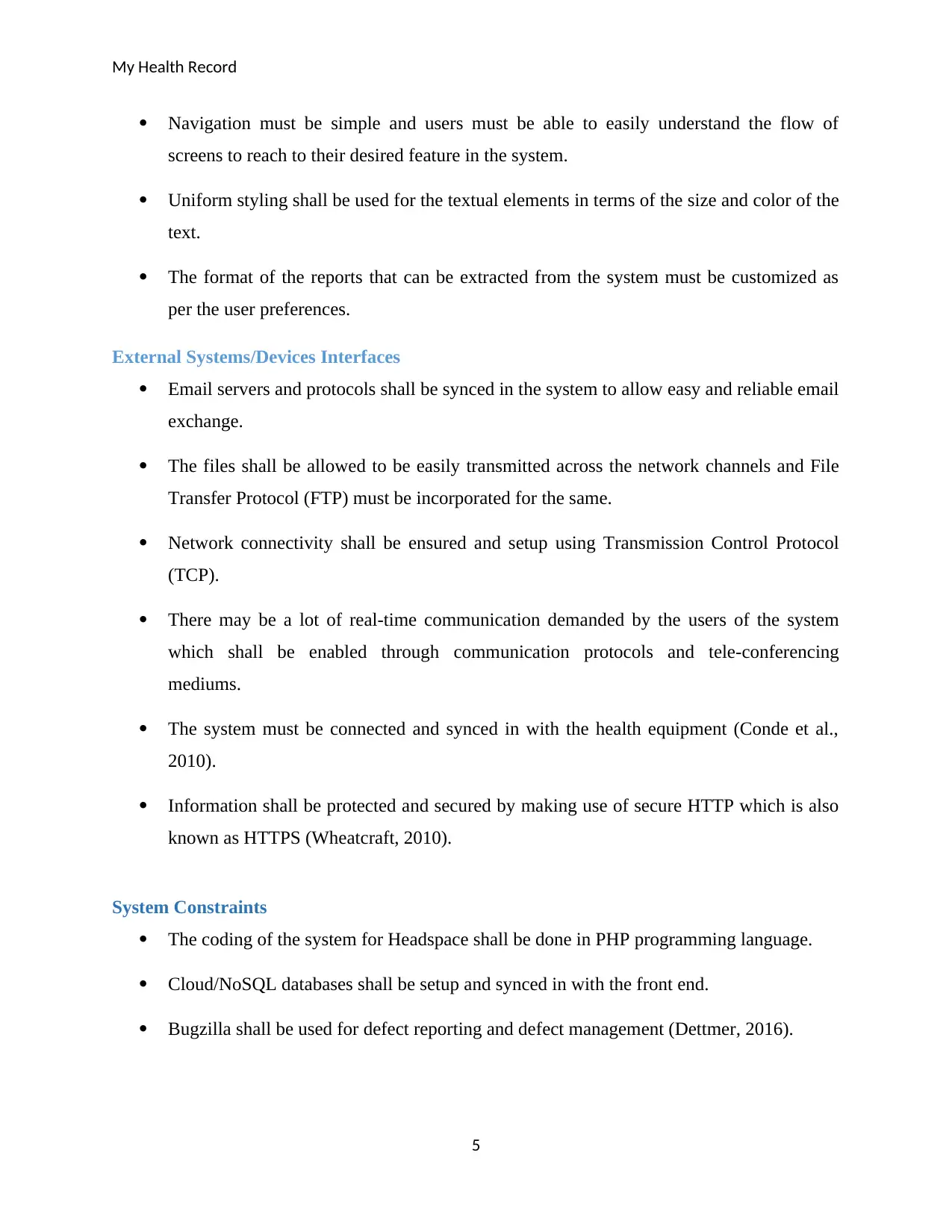
My Health Record
Navigation must be simple and users must be able to easily understand the flow of
screens to reach to their desired feature in the system.
Uniform styling shall be used for the textual elements in terms of the size and color of the
text.
The format of the reports that can be extracted from the system must be customized as
per the user preferences.
External Systems/Devices Interfaces
Email servers and protocols shall be synced in the system to allow easy and reliable email
exchange.
The files shall be allowed to be easily transmitted across the network channels and File
Transfer Protocol (FTP) must be incorporated for the same.
Network connectivity shall be ensured and setup using Transmission Control Protocol
(TCP).
There may be a lot of real-time communication demanded by the users of the system
which shall be enabled through communication protocols and tele-conferencing
mediums.
The system must be connected and synced in with the health equipment (Conde et al.,
2010).
Information shall be protected and secured by making use of secure HTTP which is also
known as HTTPS (Wheatcraft, 2010).
System Constraints
The coding of the system for Headspace shall be done in PHP programming language.
Cloud/NoSQL databases shall be setup and synced in with the front end.
Bugzilla shall be used for defect reporting and defect management (Dettmer, 2016).
5
Navigation must be simple and users must be able to easily understand the flow of
screens to reach to their desired feature in the system.
Uniform styling shall be used for the textual elements in terms of the size and color of the
text.
The format of the reports that can be extracted from the system must be customized as
per the user preferences.
External Systems/Devices Interfaces
Email servers and protocols shall be synced in the system to allow easy and reliable email
exchange.
The files shall be allowed to be easily transmitted across the network channels and File
Transfer Protocol (FTP) must be incorporated for the same.
Network connectivity shall be ensured and setup using Transmission Control Protocol
(TCP).
There may be a lot of real-time communication demanded by the users of the system
which shall be enabled through communication protocols and tele-conferencing
mediums.
The system must be connected and synced in with the health equipment (Conde et al.,
2010).
Information shall be protected and secured by making use of secure HTTP which is also
known as HTTPS (Wheatcraft, 2010).
System Constraints
The coding of the system for Headspace shall be done in PHP programming language.
Cloud/NoSQL databases shall be setup and synced in with the front end.
Bugzilla shall be used for defect reporting and defect management (Dettmer, 2016).
5
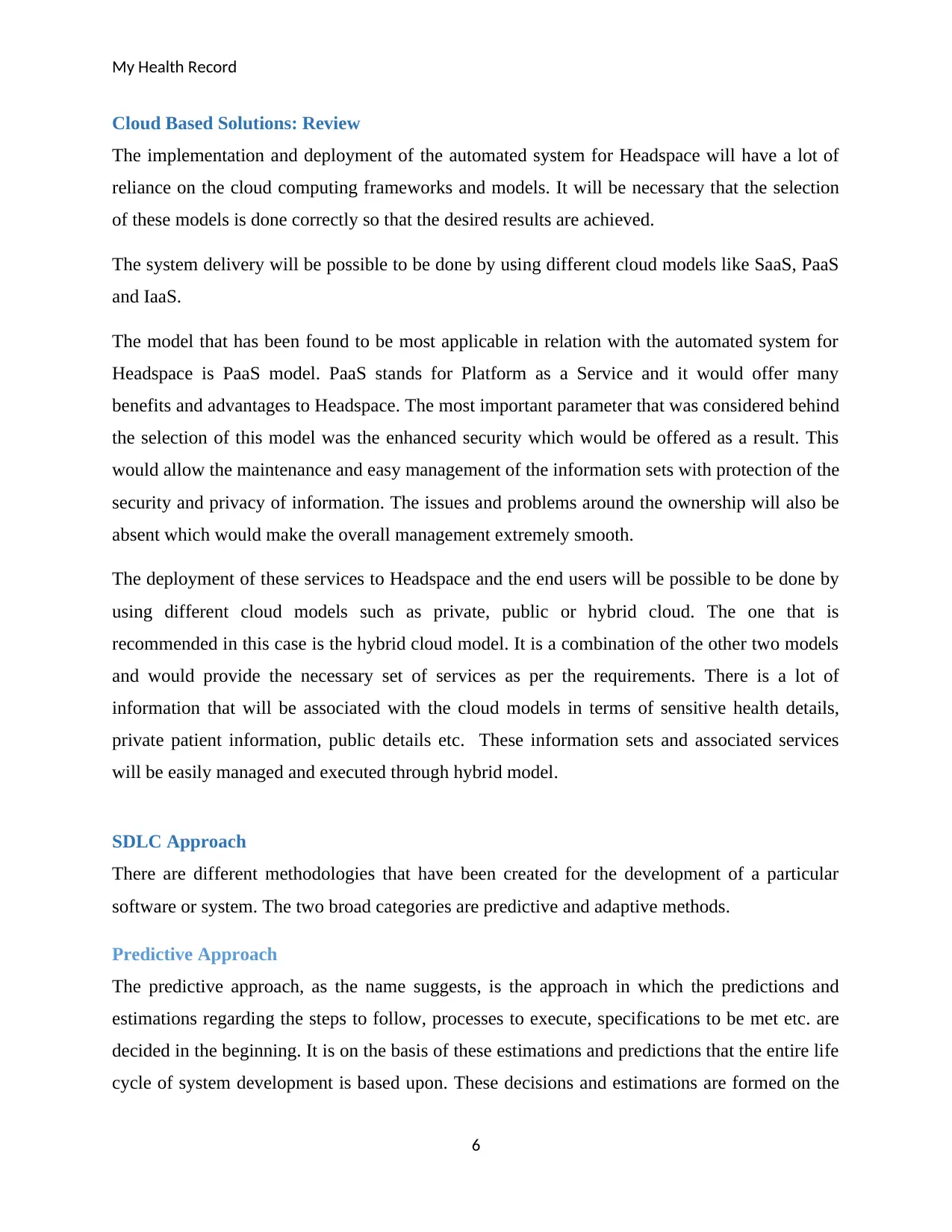
My Health Record
Cloud Based Solutions: Review
The implementation and deployment of the automated system for Headspace will have a lot of
reliance on the cloud computing frameworks and models. It will be necessary that the selection
of these models is done correctly so that the desired results are achieved.
The system delivery will be possible to be done by using different cloud models like SaaS, PaaS
and IaaS.
The model that has been found to be most applicable in relation with the automated system for
Headspace is PaaS model. PaaS stands for Platform as a Service and it would offer many
benefits and advantages to Headspace. The most important parameter that was considered behind
the selection of this model was the enhanced security which would be offered as a result. This
would allow the maintenance and easy management of the information sets with protection of the
security and privacy of information. The issues and problems around the ownership will also be
absent which would make the overall management extremely smooth.
The deployment of these services to Headspace and the end users will be possible to be done by
using different cloud models such as private, public or hybrid cloud. The one that is
recommended in this case is the hybrid cloud model. It is a combination of the other two models
and would provide the necessary set of services as per the requirements. There is a lot of
information that will be associated with the cloud models in terms of sensitive health details,
private patient information, public details etc. These information sets and associated services
will be easily managed and executed through hybrid model.
SDLC Approach
There are different methodologies that have been created for the development of a particular
software or system. The two broad categories are predictive and adaptive methods.
Predictive Approach
The predictive approach, as the name suggests, is the approach in which the predictions and
estimations regarding the steps to follow, processes to execute, specifications to be met etc. are
decided in the beginning. It is on the basis of these estimations and predictions that the entire life
cycle of system development is based upon. These decisions and estimations are formed on the
6
Cloud Based Solutions: Review
The implementation and deployment of the automated system for Headspace will have a lot of
reliance on the cloud computing frameworks and models. It will be necessary that the selection
of these models is done correctly so that the desired results are achieved.
The system delivery will be possible to be done by using different cloud models like SaaS, PaaS
and IaaS.
The model that has been found to be most applicable in relation with the automated system for
Headspace is PaaS model. PaaS stands for Platform as a Service and it would offer many
benefits and advantages to Headspace. The most important parameter that was considered behind
the selection of this model was the enhanced security which would be offered as a result. This
would allow the maintenance and easy management of the information sets with protection of the
security and privacy of information. The issues and problems around the ownership will also be
absent which would make the overall management extremely smooth.
The deployment of these services to Headspace and the end users will be possible to be done by
using different cloud models such as private, public or hybrid cloud. The one that is
recommended in this case is the hybrid cloud model. It is a combination of the other two models
and would provide the necessary set of services as per the requirements. There is a lot of
information that will be associated with the cloud models in terms of sensitive health details,
private patient information, public details etc. These information sets and associated services
will be easily managed and executed through hybrid model.
SDLC Approach
There are different methodologies that have been created for the development of a particular
software or system. The two broad categories are predictive and adaptive methods.
Predictive Approach
The predictive approach, as the name suggests, is the approach in which the predictions and
estimations regarding the steps to follow, processes to execute, specifications to be met etc. are
decided in the beginning. It is on the basis of these estimations and predictions that the entire life
cycle of system development is based upon. These decisions and estimations are formed on the
6
⊘ This is a preview!⊘
Do you want full access?
Subscribe today to unlock all pages.

Trusted by 1+ million students worldwide
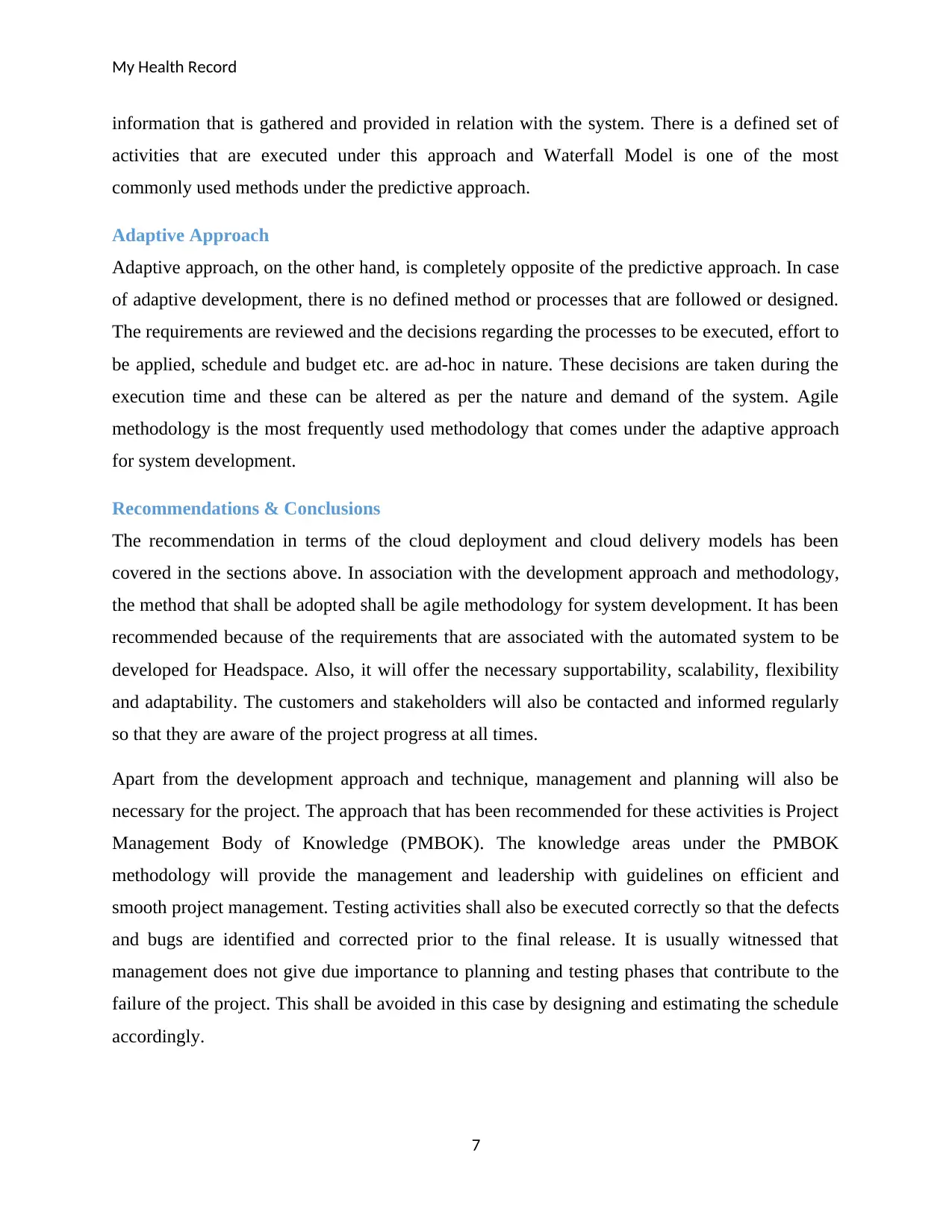
My Health Record
information that is gathered and provided in relation with the system. There is a defined set of
activities that are executed under this approach and Waterfall Model is one of the most
commonly used methods under the predictive approach.
Adaptive Approach
Adaptive approach, on the other hand, is completely opposite of the predictive approach. In case
of adaptive development, there is no defined method or processes that are followed or designed.
The requirements are reviewed and the decisions regarding the processes to be executed, effort to
be applied, schedule and budget etc. are ad-hoc in nature. These decisions are taken during the
execution time and these can be altered as per the nature and demand of the system. Agile
methodology is the most frequently used methodology that comes under the adaptive approach
for system development.
Recommendations & Conclusions
The recommendation in terms of the cloud deployment and cloud delivery models has been
covered in the sections above. In association with the development approach and methodology,
the method that shall be adopted shall be agile methodology for system development. It has been
recommended because of the requirements that are associated with the automated system to be
developed for Headspace. Also, it will offer the necessary supportability, scalability, flexibility
and adaptability. The customers and stakeholders will also be contacted and informed regularly
so that they are aware of the project progress at all times.
Apart from the development approach and technique, management and planning will also be
necessary for the project. The approach that has been recommended for these activities is Project
Management Body of Knowledge (PMBOK). The knowledge areas under the PMBOK
methodology will provide the management and leadership with guidelines on efficient and
smooth project management. Testing activities shall also be executed correctly so that the defects
and bugs are identified and corrected prior to the final release. It is usually witnessed that
management does not give due importance to planning and testing phases that contribute to the
failure of the project. This shall be avoided in this case by designing and estimating the schedule
accordingly.
7
information that is gathered and provided in relation with the system. There is a defined set of
activities that are executed under this approach and Waterfall Model is one of the most
commonly used methods under the predictive approach.
Adaptive Approach
Adaptive approach, on the other hand, is completely opposite of the predictive approach. In case
of adaptive development, there is no defined method or processes that are followed or designed.
The requirements are reviewed and the decisions regarding the processes to be executed, effort to
be applied, schedule and budget etc. are ad-hoc in nature. These decisions are taken during the
execution time and these can be altered as per the nature and demand of the system. Agile
methodology is the most frequently used methodology that comes under the adaptive approach
for system development.
Recommendations & Conclusions
The recommendation in terms of the cloud deployment and cloud delivery models has been
covered in the sections above. In association with the development approach and methodology,
the method that shall be adopted shall be agile methodology for system development. It has been
recommended because of the requirements that are associated with the automated system to be
developed for Headspace. Also, it will offer the necessary supportability, scalability, flexibility
and adaptability. The customers and stakeholders will also be contacted and informed regularly
so that they are aware of the project progress at all times.
Apart from the development approach and technique, management and planning will also be
necessary for the project. The approach that has been recommended for these activities is Project
Management Body of Knowledge (PMBOK). The knowledge areas under the PMBOK
methodology will provide the management and leadership with guidelines on efficient and
smooth project management. Testing activities shall also be executed correctly so that the defects
and bugs are identified and corrected prior to the final release. It is usually witnessed that
management does not give due importance to planning and testing phases that contribute to the
failure of the project. This shall be avoided in this case by designing and estimating the schedule
accordingly.
7
Paraphrase This Document
Need a fresh take? Get an instant paraphrase of this document with our AI Paraphraser

My Health Record
8
8
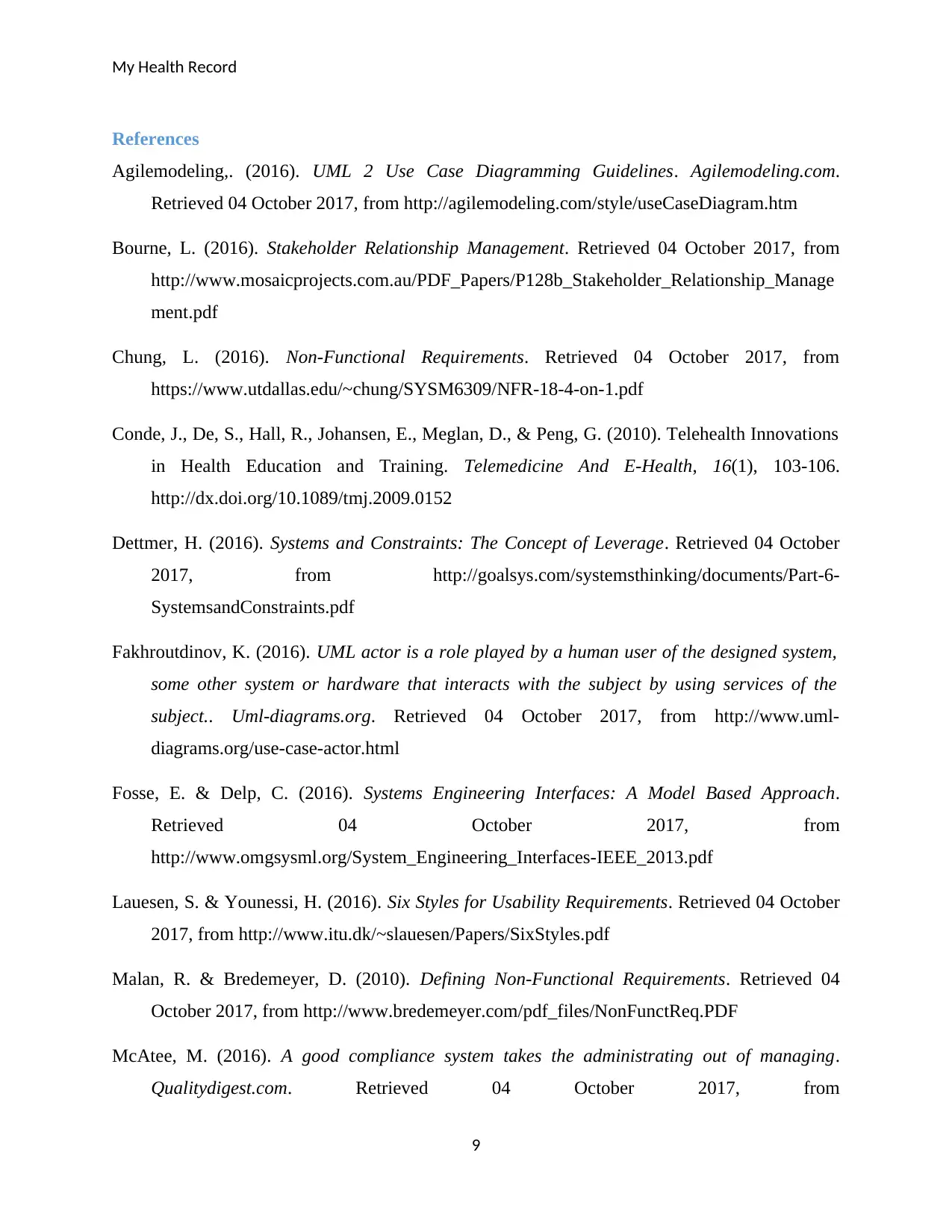
My Health Record
References
Agilemodeling,. (2016). UML 2 Use Case Diagramming Guidelines. Agilemodeling.com.
Retrieved 04 October 2017, from http://agilemodeling.com/style/useCaseDiagram.htm
Bourne, L. (2016). Stakeholder Relationship Management. Retrieved 04 October 2017, from
http://www.mosaicprojects.com.au/PDF_Papers/P128b_Stakeholder_Relationship_Manage
ment.pdf
Chung, L. (2016). Non-Functional Requirements. Retrieved 04 October 2017, from
https://www.utdallas.edu/~chung/SYSM6309/NFR-18-4-on-1.pdf
Conde, J., De, S., Hall, R., Johansen, E., Meglan, D., & Peng, G. (2010). Telehealth Innovations
in Health Education and Training. Telemedicine And E-Health, 16(1), 103-106.
http://dx.doi.org/10.1089/tmj.2009.0152
Dettmer, H. (2016). Systems and Constraints: The Concept of Leverage. Retrieved 04 October
2017, from http://goalsys.com/systemsthinking/documents/Part-6-
SystemsandConstraints.pdf
Fakhroutdinov, K. (2016). UML actor is a role played by a human user of the designed system,
some other system or hardware that interacts with the subject by using services of the
subject.. Uml-diagrams.org. Retrieved 04 October 2017, from http://www.uml-
diagrams.org/use-case-actor.html
Fosse, E. & Delp, C. (2016). Systems Engineering Interfaces: A Model Based Approach.
Retrieved 04 October 2017, from
http://www.omgsysml.org/System_Engineering_Interfaces-IEEE_2013.pdf
Lauesen, S. & Younessi, H. (2016). Six Styles for Usability Requirements. Retrieved 04 October
2017, from http://www.itu.dk/~slauesen/Papers/SixStyles.pdf
Malan, R. & Bredemeyer, D. (2010). Defining Non-Functional Requirements. Retrieved 04
October 2017, from http://www.bredemeyer.com/pdf_files/NonFunctReq.PDF
McAtee, M. (2016). A good compliance system takes the administrating out of managing.
Qualitydigest.com. Retrieved 04 October 2017, from
9
References
Agilemodeling,. (2016). UML 2 Use Case Diagramming Guidelines. Agilemodeling.com.
Retrieved 04 October 2017, from http://agilemodeling.com/style/useCaseDiagram.htm
Bourne, L. (2016). Stakeholder Relationship Management. Retrieved 04 October 2017, from
http://www.mosaicprojects.com.au/PDF_Papers/P128b_Stakeholder_Relationship_Manage
ment.pdf
Chung, L. (2016). Non-Functional Requirements. Retrieved 04 October 2017, from
https://www.utdallas.edu/~chung/SYSM6309/NFR-18-4-on-1.pdf
Conde, J., De, S., Hall, R., Johansen, E., Meglan, D., & Peng, G. (2010). Telehealth Innovations
in Health Education and Training. Telemedicine And E-Health, 16(1), 103-106.
http://dx.doi.org/10.1089/tmj.2009.0152
Dettmer, H. (2016). Systems and Constraints: The Concept of Leverage. Retrieved 04 October
2017, from http://goalsys.com/systemsthinking/documents/Part-6-
SystemsandConstraints.pdf
Fakhroutdinov, K. (2016). UML actor is a role played by a human user of the designed system,
some other system or hardware that interacts with the subject by using services of the
subject.. Uml-diagrams.org. Retrieved 04 October 2017, from http://www.uml-
diagrams.org/use-case-actor.html
Fosse, E. & Delp, C. (2016). Systems Engineering Interfaces: A Model Based Approach.
Retrieved 04 October 2017, from
http://www.omgsysml.org/System_Engineering_Interfaces-IEEE_2013.pdf
Lauesen, S. & Younessi, H. (2016). Six Styles for Usability Requirements. Retrieved 04 October
2017, from http://www.itu.dk/~slauesen/Papers/SixStyles.pdf
Malan, R. & Bredemeyer, D. (2010). Defining Non-Functional Requirements. Retrieved 04
October 2017, from http://www.bredemeyer.com/pdf_files/NonFunctReq.PDF
McAtee, M. (2016). A good compliance system takes the administrating out of managing.
Qualitydigest.com. Retrieved 04 October 2017, from
9
⊘ This is a preview!⊘
Do you want full access?
Subscribe today to unlock all pages.

Trusted by 1+ million students worldwide
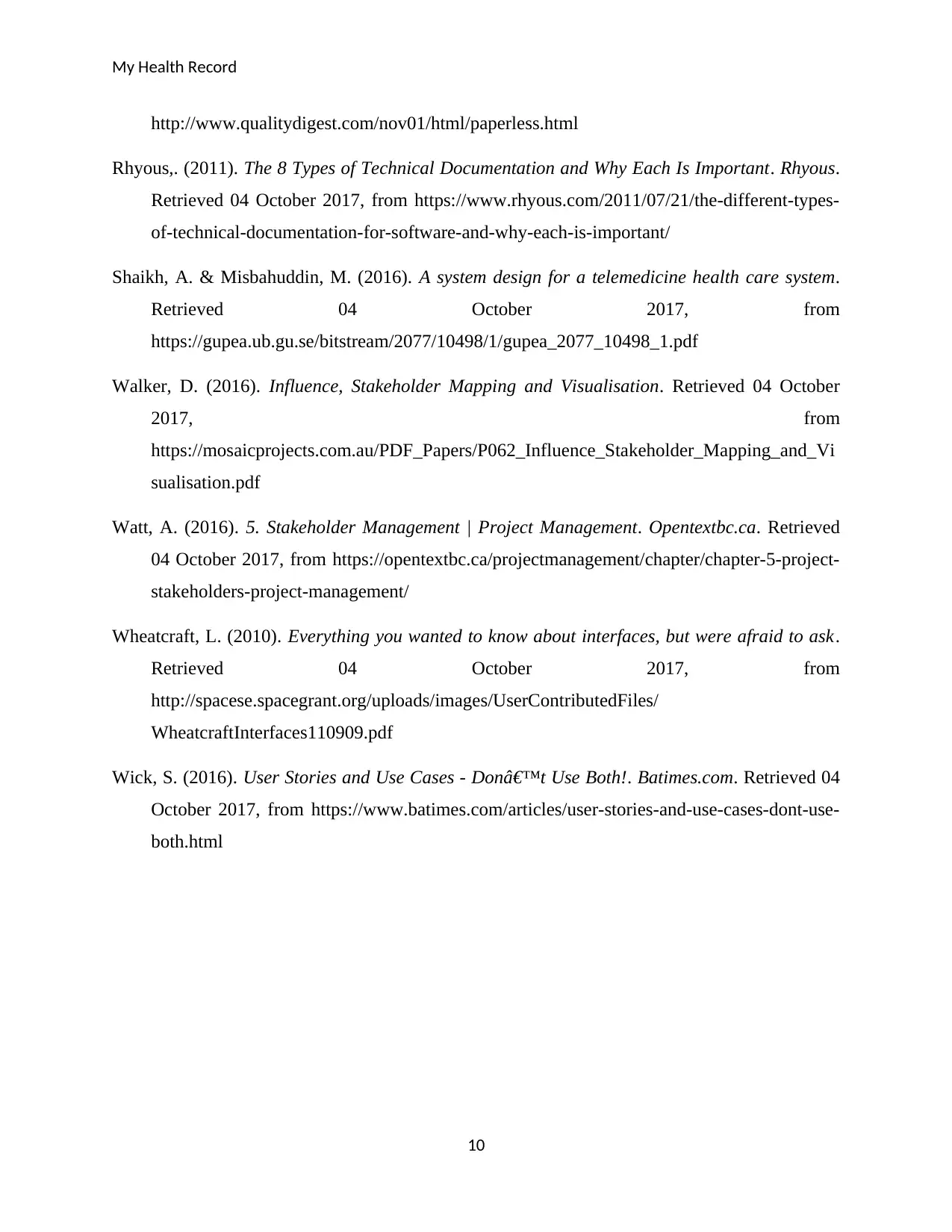
My Health Record
http://www.qualitydigest.com/nov01/html/paperless.html
Rhyous,. (2011). The 8 Types of Technical Documentation and Why Each Is Important. Rhyous.
Retrieved 04 October 2017, from https://www.rhyous.com/2011/07/21/the-different-types-
of-technical-documentation-for-software-and-why-each-is-important/
Shaikh, A. & Misbahuddin, M. (2016). A system design for a telemedicine health care system.
Retrieved 04 October 2017, from
https://gupea.ub.gu.se/bitstream/2077/10498/1/gupea_2077_10498_1.pdf
Walker, D. (2016). Influence, Stakeholder Mapping and Visualisation. Retrieved 04 October
2017, from
https://mosaicprojects.com.au/PDF_Papers/P062_Influence_Stakeholder_Mapping_and_Vi
sualisation.pdf
Watt, A. (2016). 5. Stakeholder Management | Project Management. Opentextbc.ca. Retrieved
04 October 2017, from https://opentextbc.ca/projectmanagement/chapter/chapter-5-project-
stakeholders-project-management/
Wheatcraft, L. (2010). Everything you wanted to know about interfaces, but were afraid to ask.
Retrieved 04 October 2017, from
http://spacese.spacegrant.org/uploads/images/UserContributedFiles/
WheatcraftInterfaces110909.pdf
Wick, S. (2016). User Stories and Use Cases - Don’t Use Both!. Batimes.com. Retrieved 04
October 2017, from https://www.batimes.com/articles/user-stories-and-use-cases-dont-use-
both.html
10
http://www.qualitydigest.com/nov01/html/paperless.html
Rhyous,. (2011). The 8 Types of Technical Documentation and Why Each Is Important. Rhyous.
Retrieved 04 October 2017, from https://www.rhyous.com/2011/07/21/the-different-types-
of-technical-documentation-for-software-and-why-each-is-important/
Shaikh, A. & Misbahuddin, M. (2016). A system design for a telemedicine health care system.
Retrieved 04 October 2017, from
https://gupea.ub.gu.se/bitstream/2077/10498/1/gupea_2077_10498_1.pdf
Walker, D. (2016). Influence, Stakeholder Mapping and Visualisation. Retrieved 04 October
2017, from
https://mosaicprojects.com.au/PDF_Papers/P062_Influence_Stakeholder_Mapping_and_Vi
sualisation.pdf
Watt, A. (2016). 5. Stakeholder Management | Project Management. Opentextbc.ca. Retrieved
04 October 2017, from https://opentextbc.ca/projectmanagement/chapter/chapter-5-project-
stakeholders-project-management/
Wheatcraft, L. (2010). Everything you wanted to know about interfaces, but were afraid to ask.
Retrieved 04 October 2017, from
http://spacese.spacegrant.org/uploads/images/UserContributedFiles/
WheatcraftInterfaces110909.pdf
Wick, S. (2016). User Stories and Use Cases - Don’t Use Both!. Batimes.com. Retrieved 04
October 2017, from https://www.batimes.com/articles/user-stories-and-use-cases-dont-use-
both.html
10
1 out of 10
Related Documents
Your All-in-One AI-Powered Toolkit for Academic Success.
+13062052269
info@desklib.com
Available 24*7 on WhatsApp / Email
![[object Object]](/_next/static/media/star-bottom.7253800d.svg)
Unlock your academic potential
Copyright © 2020–2025 A2Z Services. All Rights Reserved. Developed and managed by ZUCOL.





